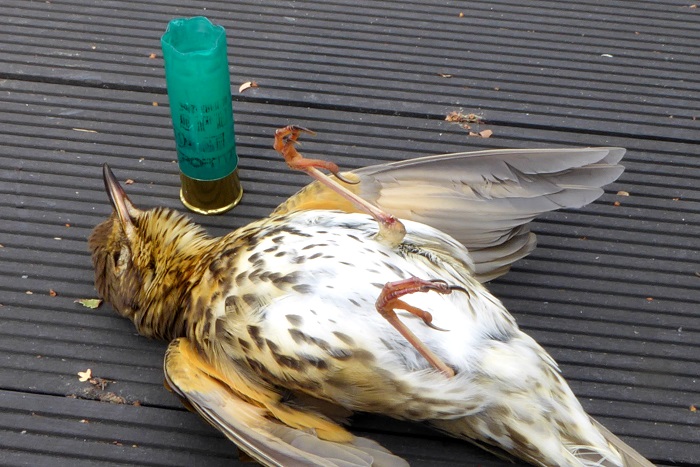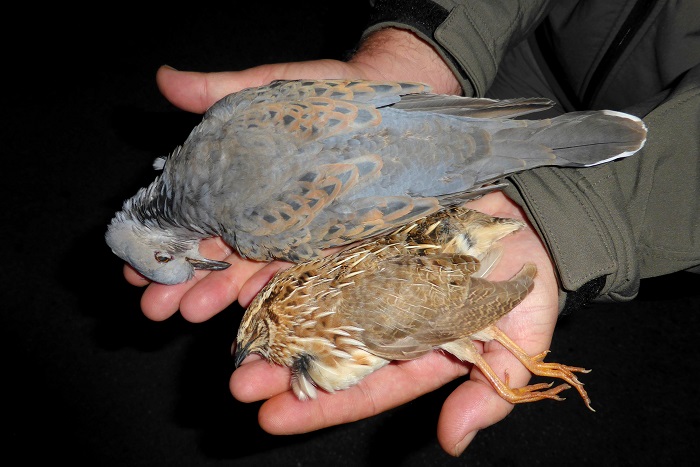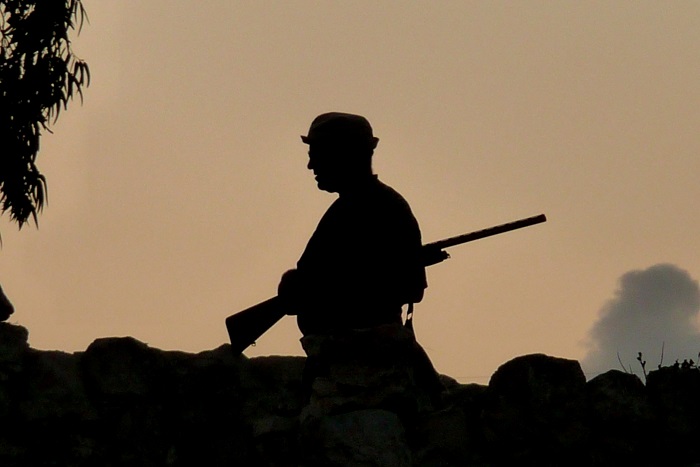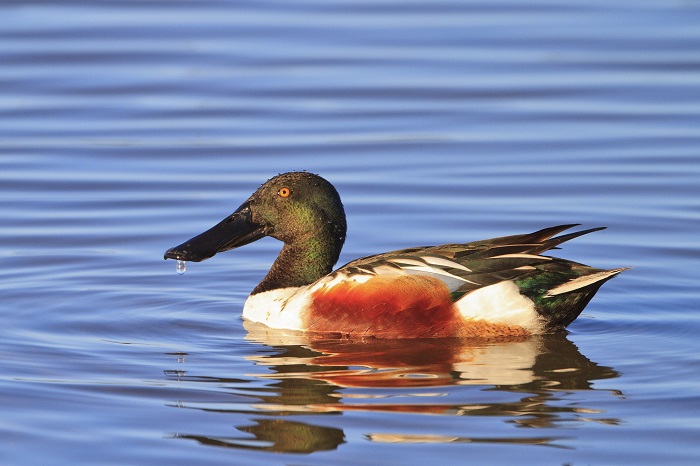Hunting bag statistics in Europe
The following text is a shortened version of the original article by the authors Axel Hirschfeld, Geraldine Attard, which was published in the journal "Berichte zum Vogelschutz" (BzV, issue 53/54, 2017) in April 2018 - an English digest by Axel Hirschfeld, Geraldine Attard and Lloyd Scott was published in the journal 'British Birds' in March 2019. It also lists all the references mentioned and the methods for estimating species-specific hunting bags from grouped-species data such as "wild ducks".
Information on the BzV can be obtained from the Deutschen Rat für Vogelschutz (German Council for the Protection of Birds).
Introduction

The hunting of birds, including migratory species, is a widespread traditional pastime which to date is practised by several millions of hunters across Europe. The framework for hunting legislation in member states of the European Union (EU) is set by the provisions of the Birds Directive 2009/147/EC (BD) which details the conditions under which 82 species of birds may be hunted legally. Against the backdrop of the significant decline of several migratory species listed in the annex II of the BD, including the Northern Lapwing Vanellus vanellus, the Turtle Dove Streptopelia Turtur or the Skylark Alauda arvensis, it is frequently discussed whether in face of their unfavourable conservation statuses, hunting can continue to be justified as sustainable or should be banned.
In order to carry out appropriate assessments for individual species or populations, data on legal hunting in the entire range must be evaluated in addition to figures on population size and reproduction. The first study which analysed the hunting bag figures or corresponding estimates for all 82 species of the BD, was published in the year 2005 (Hirschfeld & Heyd, 2005). To provide an overview of the current hunting pressures on endangered species and to compare the results with those provided by Hirschfeld and Heyd (2005), the study was repeated in 2016 (Hirschfeld and Attard, 2017). The aim of this publication is to provide an overview of the current hunting pressure on these species in Europe and to compare the results with those of the older study.
Materials and Methods
In 2016, on the initiative and with financial support of the German Council for the Protection of Birds (DRV), members of the Committee Against Bird Slaughter (CABS) systematically compiled all available national hunting statistics from EU countries, Switzerland and Norway and evaluated the data contained therein for the 82 bird species listed in Annex II of the Birds Directive.
In a first working phase, extending from June to November 2016, all publicly available hunting statistics were compiled. Hunting bags that were not publicly accessible were requested from national hunting authorities, regulatory bodies and bird conservation organisations. By the end of the research phase, datasets for 26 of the 30 study countries were collected. In order to analyse concordant data, the study aimed to record national hunting bags from the same hunting period. Overall, the most frequently available data were from the hunting season 2014/15 or calendar year 2014. If hunting bags for this period were not available, the most recent ones were recorded (see table below).
Results

For the investigation period, a total of 598 individual bags were determined or estimated from the available sources, corresponding to approximately 78% of all possible 763 datapoints. Of these, 487 were reported as being accurate and 113 were estimated based on summarised bags or regional data in the case of Italy. The total of all species-specific bags, summarised bags and extrapolated Italian bags for the study period is of at least 52 million birds of the 82 studied species. The table below provides information on the study area, the number of hunters, the number of bird species that can be hunted, the total number of birds that can be shot and the data quality in all 30 countries surveyed.
Among the species assessed, several are facing an important decline in populations (table 3). The hunting status of species that are considered to be at risk in Europe and/or in a particular member state, are therefore of important interest to nature conservation and to evaluate potential causes of this decline.
| Country | Number of hunters | Hunter density | Number of birds killed | Hunting season | Number of huntable species |
| Belgium | 23.000 | 0,75 | 1.019.701 | 2014 | 13 |
| Bulgaria | 120.000 | 1,08 | 548.062 | 2013/14 | 25 |
| Denmark | 178.000 | 4,15 | 2.062.054 | 2014/15 | 30 |
| Germany | 374.084 | 1,05 | 1.156.149 | 2014/15 | 30 |
| Estonia | 15.000 | 0,33 | 17.252 | 2014/15 | 32 |
| Finland | 207.000 | 0,61 | 1.265.700 | 2014 | 30 |
| France | 1.250.000 | 1,94 | 17.624.996 | 2013/14 | 63 |
| Greece | 174.500 | 1,32 | ? | - | 32 |
| Ireland | 350.000 | 4,98 | ? | - | 19 |
| Italy | 689.000 | 2,29 | 3.702.797* | 2014/14 | 34 |
| Croatia | 56.327 | 0,99 | 150.191 | 2014/15 | 21 |
| Latvia | 25.000 | 0,39 | 21.507 | 2014/15 | 28 |
| Lithuania | 32.000 | 0,49 | 13.116 | 2014 | 16 |
| Luxemburg | 2.080 | 0,8 | 1.948 | 2014/15 | 3 |
| Malta | 11.076 | 35,05 | 121.496 | 2014 | 32 |
| Netherlands | 27.000 | 0,65 | ? | - | 10 |
| Norway | 142.850 | 0,37 | 449.920 | 2014/15 | 29 |
| Austria | 123.283 | 1,47 | 154.114 | 2014/15 | 26 |
| Poland | 118.362 | 0,38 | 211.096 | 2014/15 | 13 |
| Portugal | 120.000 | 1,3 | 1.562.224 | 2013/14 | 30 |
| Romania | 60.000 | 0,25 | 1.256.876 | 2014/15 | 39 |
| Slovakia | 38.719 | 1,02 | 113.748 | 2014/15 | 20 |
| Slovenia | 22.000 | 1,1 | 32.456 | 2014 | 6 |
| Spain | 906.437 | 1,79 | 11.933.963 | 2014/15 | 32 |
| Swenden | 300.000 | 0,67 | 549.585 | 2014/15 | 33 |
| Switzerland | 29.864 | 0,72 | 27.513 | 2014 | 22 |
| Czech Republic | 92.247 | 1,17 | 783.265 | 2014 | 14 |
| Hungary | 59.053 | 0,63 | 548.392 | 2013/14 | 14 |
| United Kingdom | 800.000 | 3,04 | ? | - | ? |
| Cyprus | 42.215 | 4,56 | 3.700.711 | 2015 | 34 |
Legend for the table: Number of hunters = number of officially registered hunters according to FACE (2010), hunter density = number of registered hunters per square kilometre, number of birds killed = number of individuals of bird species of Annex II of the BD shot during the hunting season/annually, hunting season = period in which the hunting bags were collected, number of huntable species = number of species that may be legally hunted
Selected species in detail:
White-fronted Goose Anser Albifrons
In the study period, 17 countries opened a hunting season for White-fronted Geese, of which 10 provided species-specific hunting bags representing a total of 37,529 birds taken. In addition, Czech Republic, Germany and Poland provided summarised bags in which the species was included. The White-fronted Goose has recently been moved from the green list to red list of species of conservation concern in the UK. However, no bag data are available for the country. A significant increase in hunting bags in six reference countries (Denmark, Estonia, Latvia, Lithuania, Hungary and Sweden) was observed; from 2,209 to 15,003 individuals between the two study periods.
Common Pochard Aythya ferina
In the study area, 22 countries authorised open seasons for Common Pochards. Of these countries, 12 provided species-specific hunting bags, representing a total of 30,645 individuals. 25,199 were harvested in France - where the species is listed with a VU conservation status. France’s wintering populations are estimated at around 75,500 individuals (Deceuninck et al., 2013), three times the number of birds taken in 2013/14 according to Aubry et al. (2016). The total species-specific bags for Common Pochards in the study area represents 14% of the EU-27 average breeding population.
Black Grouse Tetrao tetrix
Listed on the UK’s red list of species of conservation concern, the Black Grouse was hunted in nine countries during the study period. Although Aebischer and Baines (2008) indicated that hunting bag trends were continuously decreasing in the UK, no bag data were available for the country. The UK populations and range are continuously declining and despite a population of less than 5,100 males (Robinson, 2017), Black Grouse hunting is still authorised. For the study, a total of six national species-specific bags were collected, representing 179,457 birds taken. In comparison this equates nearly 10% of the EU-27 average breeding population. The highest bag figure was from Finland with 136,700 birds, followed by Sweden and Norway with respectively 20,566 and 20,120 birds harvested.
Common Quail Coturnix coturnix
During the investigation period, open seasons for Common Quails were in effect in 10 EU countries, of which six provided species-specific hunting bags representing a total of 1,531,890 birds - equal to 40% of the EU-27 average breeding population. In addition, the total number of quails taken in Italy was estimated at 76,064 individuals. The country with the highest bag figure for Common Quails is Spain with 1,223,464 birds taken. The Spanish average breeding population has been estimated at around 925,000 mature individuals (Carrascal and Palomino, 2008), therefore it can be assumed that an important proportion of harvested Common Quails are originating from other countries or are captive-reared. The proportion of captive-reared Common Quails in hunting bags is generally not known, although in some areas their population exceed that of wild birds (Sanchez-Donoso et al., 2012). For Greece, Bulgaria and Portugal no current bag figures could be evaluated, however, the EU management plan for the species (European Commission 2009a), indicate that the annual bags in Greece are estimated at 72,000 individuals and around 275,000 in Bulgaria. The number of Common Quails reported as being shot in three sample countries (France, Cyprus, Malta) has declined from 363,000 to 215,230 individuals between the two study periods.

Northern Lapwing Vanellus vanellus
During the study period, Northern Lapwings were hunted in five EU countries, of which three countries released species-specific bags including 107,802 birds. Nearly 90% of these birds were killed in France - in which the species’ conservation status is “Near Threatened” (NT). In addition, the total hunting bag in Italy was estimated at 7,489 individuals. Current data from Greece are missing, although the EU management plan (European Commission, 2009b) estimated that 100,000 birds were taken annually. A trend could be estimated based on two countries (France and Malta) and indicated a decrease in hunting bags of 78% between the two study periods.
Woodcock Scolopax rusticola
The species is legally hunted in 26 countries of the investigation area, of which 21 provided species-specific hunting bags representing 973,414 birds - equal to 44% of the EU-27 average breeding population. In addition, the estimated number of Woodcocks taken in Italy is estimated at 144,099 individuals. No bag figures were available for the UK, Ireland, Bulgaria and Greece. Hirschfeld and Heyd (2005) indicated that around 125,000-150,000 Woodcocks were annually harvested in the UK and trends show that hunting bags have been stable for the last 20 years (Aebischer and Baines, 2008). A comparison based on 16 countries from which datasets are available for both reference periods, indicate a reduction in the number of birds taken from 1,277,606 to 819,210.
Turtle Dove Streptopelia turtur
For the study period, eight of 10 countries which opened a hunting season for Turtle Doves provided species-specific hunting bags totalling 1,455,208 birds - equal to 22% of the EU-27 average breeding population. Spain, which has the largest breeding population in the study area, provided the highest bag figure with a total of 701,600 Turtle Doves taken. In neighbouring countries, Portugal and France, hunting bags were respectively of 109,815 and 91,704 birds - despite VU conservation status in France (IUCN France et al., 2016). Sorrenti and Tramontana (2016) estimated a number of 305,590 Turtle Doves taken in Italy during the hunting season 2014/15. No recent hunting bag statistics were available for Greece, although the EU management plan for the species (European Commission 2007b) indicated that between 300,000 and 600,000 Turtle Doves are harvested in the country ever year. However, in view of the species’ progressive decline in its entire area of distribution, the number of Turtle Doves currently shot in Greece most likely falls below this estimation. Until 2016, Malta was the only country which opened a season for Turtle Doves in April and therefore, the recent hunting ban in spring does not account in the overall decrease in hunting of these birds in three sample countries (France, Malta and Portugal), in which hunting bags have fallen from 323,933 to 208,133 between the two study periods.
Skylark Alauda arvensis
Of the six countries in which Skylarks could be hunted during the investigation period, four countries provided species-specific bag figures representing a total of 898,958 birds. In addition, the total hunting bag in Italy was estimated at 451,671 birds. No figures were available for Greece, where the species is a popular hunting prey, although, the EU management plan (European Commission 2007a) indicate an estimated annual hunting bag of 180,000-400,000 birds. However, in view of the trends in hunting bags in other countries, a decline in numbers must also be assumed in Greece. In recent years, the shooting in the sample countries France and Malta has fallen from 684,135 to 194,229 birds, corresponding to a decrease of around 72%. In fact, the declining population in France has recently led to a re-evaluation of the species’ conservation status in the country from LC to NT (IUCN France et al., 2016).
Song Thrush Turdus philomelos
The species is listed with open hunting seasons in eight countries of the study area, five of which provided species-specific hunting bags representing 5,056,551 birds - equal to 14% of the EU-27 average breeding population. In addition to this total, the estimated number of birds killed is of around 2,954,311 in Italy and 2,872,691 in Spain. Cyprus and France respectively reported total bags of 2,749,144 and 1,426,165 birds. The French bag figure equates to nearly 60% of the national breeding population (BirdLife International, 2015). The current number of Song Thrushes annually harvested in Greece is not known, although Hirschfeld and Heyd (2005) indicated a bag figure of 3,751,514. In one reference country (Malta), the number of Song Thrushes killed annually has decreased by 58% between both study periods.
Validity of the data

For some species such as Common Pheasants, Common Quails, Mallards, Grey Partridges, and some members of the genus Alectoris, hunting bags also include captive-reared birds. However, their exact proportion in the total species-specific bags is generally not known; making it more difficult to assess the consequences for wild bird populations. On the other hand it must be considered that for most species the total estimated bags are only a proportion of the total losses caused by hunting. Since approximately 20% of all hunters registered in the study area live in the UK, Ireland, the Netherlands and Greece (see Table 1) for which there was no available bag data, a corresponding "dark figure" must be expected for most of the 46 species which can be hunted in these countries. Additionally, numerous species-specific hunting bags were not included in the datasets of the countries under investigation.
Also unknown is the number of birds that were injured by pellets, die undetected or have limited reproductive performance due to hunt-related injuries, and the losses due to illegal persecution which for some species constitute a significant cause of mortality. In the study area, examples include the illegal spring hunting of Turtle Doves and Common Quails in southern Italy, Greece and several Balkan countries and the large scale illegal trapping of thrushes in Cyprus and Italy (Birdlife International, 2011; Brochet et al., 2016; Debersek and Rutigliano, 2016). Brochet et al. (2016) indicated that Common Quails and Song Thrushes are respectively the 4th and 5th most targeted species with an estimated 2,9 million individuals (mean value) of both species illegally killed every year in the Mediterranean region.
Due to their popularity and their status among many bird hunters, Turle Doves and Common Quails are particularly affected by shooting or trapping outside the study area. Both species are killed (legally or illegally) in almost all the countries of southern Europe, the Balkans, the Arabian Peninsula and the Maghreb countries (European Commission, 2007b, 2009a; Fisher et al., 2016), some of which allow additional hunting of birds returning to their breeding grounds in spring. For instance, Omer (2015) reports that Common Quails are an important source of food for many residents of the Gaza Strip during the migratory season. Also in Lebanon, every spring and autumn, hundreds of thousands of European migratory birds are shot for human consumption, including Common Quails, species of thrushes, Turtle Doves and waterfowl (CABS, 2013). Therefore, a particularly high additional hunting pressure is to be expected outside the study area.

Depending on the species, the proportion of migratory birds breeding in the EU is between 0% (e.g. White-fronted Goose Anser albifrons) and 100% (e.g. Capercaillie Tetrao urogallus). However, the exact proportion of the so-called flyway population (Rose, 1998) is still unknown for most of the migrating species in Europe, making the consequences of hunting more difficult to accurately estimate (Madsen et al., 2015). Comparing the annual bag figures determined for the study area to the European breeding populations shows that the minimum total number of birds shot legally in countries that provided accurate statistics sometimes nearly reaches half of the average breeding population in Europe (see section 3). For instance, for the Jack Snipe Lymnocryptes minimus, the total hunting bag reported for France, Portugal, Malta and Romania represents 45,716 individuals, estimations for Italy and Spain include 3,880 and ±2,355 individuals respectively, and the species is also hunted in Cyprus, Ireland and the UK (no available data). Even without the missing data, the total bags in the study area is approximately equal to the maximum European breeding population (23,100 pairs).
With approximately 2.3 million Turtle Doves annually killed between the years 1980 and 2002 (Hirschfeld and Heyd, 2005) and approximately 1.5 million annually killed between 2003 and 2013, the total number of Turtle Doves killed in the study area between 1980 and 2013 can be estimated to at least 65 million individuals. These estimations do not include bag data for Greece, therefore the number of Turtle Doves killed by hunters in the study area can be considered significantly higher. In the same period the European Turtle Dove population decreased by 78% (European Bird Census Council, 2015).
Conclusion
Against the backdrop of the high losses caused by hunting and the ever-shrinking population of many game species, there is no doubt that such persecutions in their entirety limits sustainable use. On the contrary, it likely contributes to the accelerated decline of many species. In our opinion, the hunting of endangered species is therefore no longer ethically and politically justifiable, especially since it is only a minority’s hobby and mostly not about stock regulation of common species in the public interest; for example, terms of many general licences such as protection of crops, livestock, human health or for aviation safety reasons. Although hunting is not the main cause of their decline in European countries, in view of the current stock situation it does not appear comprehensible to consider further killings to be accepted for reasons such as “harvesting a surplus” or tradition.
Article 7 section 1 of the BD states: “Member States shall ensure that the hunting of these species does not jeopardise conservation efforts in their distribution area”. However, if European countries continue to authorise the hunting of endangered species, conservation efforts will be void and the species become increasingly endangered. Wildlife conservation organisations should make a clear counter-proposal against such unilaterally motivated justification attempts and rigourously campaign for hunting bans on endangered species in the individual countries. If these efforts fail, the EU must be persuaded to exert pressure on the respective governments and, if necessary, to bring proceedings before the European Court of Justice for infringement of the BD.
Download the publication
Read the entire article that was published in 2019 in "British Birds" - download available here:






